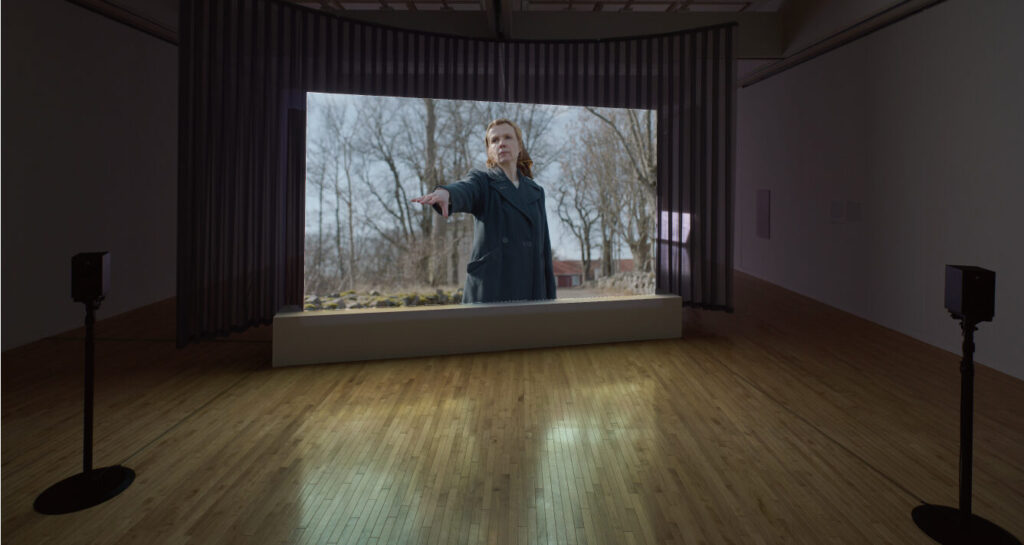
Daisuke Kosugi, All that goes before forget, 2021. Installation view, MOT Annual 2021: A sea, a living room and a skull, Museum of Contemorary Art Tokyo, 2021. Photo: Kenji Morita.
Daisuke Kosugi - Somewhat Infrequently
- 26 May - 14 July 2022
- Daiwa Anglo-Japanese Foundation, 13/14 Cornwall Terrace, Outer Circle, London NW1 4QP
- https://dajf.org.uk/exhibitions/daisuke-kosugi-somewhat-infrequently
- 020 7486 4348
- events@dajf.org.uk
- Tweet
A private view of this exhibition will be held on 26 May 2022. For more details, please visit the Daiwa Foundation website.
The Daiwa Anglo-Japanese Foundation is pleased to present Daisuke Kosugi’s first UK solo exhibition Somewhat Infrequently. The show will feature Kosugi’s two most recent works, A False Weight (2019) and All that goes before forget (2021).
A False Weight (2019) explores how domestic and social architecture represent certain ideas and mould our movement and habits. In this work Toru Iwashita, a Butoh dancer, depicts Kosugi’s father Masanori Kosugi, who suffers from a chronic degenerative brain disease affecting his mobility and balance. The film shows repeating sequences of his daily routine at different stages of the disease’s progression, and being in step with his movements we become conscious of the notion of time as a normalised construct. Carefully avoiding objectifying the disease, throughout its 49 minutes the film presents a series of static images with subtle differences between them. By doing this Kosugi makes us question what we thought we knew about memory, and how it determines what remains and what is lost in the flow of time.
All that goes before forget (2021) attempts to portray post-traumatic stress disorder experiences. Titled from the opening sentence of Samuel Beckett’s short prose piece ‘Enough’, the work mirrors how Beckett worked with the text, defying his readers’ ability to narrate a story. The film seemingly consists of three protagonists, a young girl in post-war Norway, a Japanese schoolgirl during WWII, and an androgyne person in their twenties in a contemporary domestic setting, yet as the title suggests, the work refuses to pin down the subjects to a specific place, a particular time, or any obvious attributes. Kosugi purposely leaves mere traces of the subjects and thus highlights their existence and potential connections beyond time and space. Conflating fiction, personal experience and recollection, the film escapes from a single, linear narrative and demands that we look at it again and again, until we notice that it is only from its peripheries that other forms of relations become possible.
While the world tries to advance and grow, desperately trying to keep up with the pace of change, Kosugi’s works make us pause and allow us to experiment with different relations and connections to ourselves and others.
About the contributors
Daisuke Kosugi
Daisuke Kosugi (b. 1984, Tokyo, Japan) lives and works in Farsund and Oslo. Kosugi utilises video as his primary medium to produce work that focuses on dislocated subjectivity in a normalised social milieu. He uses moving images as his method to distort our sense of time and make us question what we thought we knew about our memory. Kosugi often works closely with his family members and other individuals to explore their inner lives, weighing the notion of real versus imaginary, probing the incommunicability of physical and mental pain, and questioning empathy.
Recent solo exhibitions include Jeu de Paume in Paris; CAPC musée d’art contemporain de Bordeaux, Museo Amparo Puebla in México and Fotogalleriet in Oslo. Kosugi’s work has been exhibited widely in Norway and in various international institutions including Centre Pompidou in Paris, Whitechapel Gallery in London, Museum of Contemporary Art Tokyo and Bonniers Konsthall in Stockholm. His newly commissioned sound installation will be premiered in STILL ALIVE, The Aichi Triennale 2022, from 30 July – 10 October.
Photo: Marte Glanville, Kulturtanken
